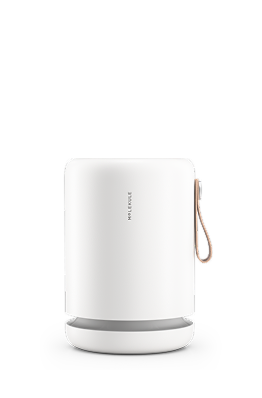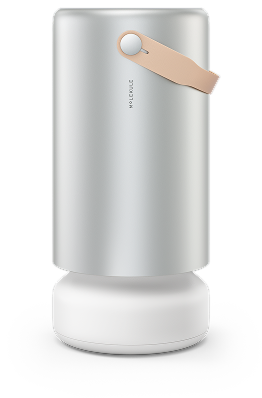It is often recommended that you open your windows to improve air quality inside your home. Outside air usually has a lower concentration of pollutants than indoor air. However, outdoor air pollution can be a serious problem for your home, especially if you live near a busy road or highway. Traffic pollutants tend to be at the highest concentrations generally within the first 500 feet of a road, and do not reach background levels until 2,000 feet away. An air purifier for nearby traffic pollution may help cut down on the traffic related pollutants you and your family inhale.
According to the EPA, studies have found that living, working, or going to school near major roadways “can lead to health effects like asthma, reduced lung function, cardiovascular disease, and premature death.” The EPA also cites connections between traffic pollution and low birth weights, and impaired lung development in infants.
Air pollution from cars and trucks comes in a few specific forms. Understanding the nature of the pollutants and how different filtration technologies act on them will help you choose the best air purifier for pollution.
The components of traffic related air pollution
Different vehicles on the roadways have different parts that pollute the environment in different ways. Cars emit different pollutants than heavy trucks with diesel engines. And a significant portion of traffic pollution comes from dust generated by brakes and tires, as well as soil dust kicked up by passing vehicles. It is impossible to know every chemical that gets into the air near a busy roadway, but they all fall into a few categories.
Vehicles directly emit carbon monoxide and nitrous oxides, and the EPA notes that, “hundreds of
Brake dust is a pollutant that is often overlooked. When you need to replace your brakes, it is because they were ground into the air by the friction of braking and became fine particles of iron, copper and manganese. These particles are tiny enough to stay in the air and be carried by the wind, potentially being inhaled by someone living or working nearby. Worse, a Georgia Tech study found that acidic sulfate in the air reacted with the metals, making them more soluble, and thus more likely to cause health problems when inhaled Fang, et al>.
Tire dust gets into the air when your tires begin to wear away. Modern synthetic rubber is made up of several chemical compounds, and the way these compounds affect the environment is not well-studied. However, inhaling tiny particles of rubber every day may impact your respiratory health.
Some of the pollution emitted by vehicle traffic is known as PM2.5. This refers to particulate matter that is 2.5 microns in size or smaller. Tire and brake dust make up part of this category, as well as other particles emitted from vehicle exhaust. The extremely small size of the particles means they are easily dispersed in the air, often over long distances. PM2.5 can only be handled by air purifiers designed to capture particles in this size range.
Traffic pollutants like benzene and other chemicals that are emitted from fuel vapor, burning oil or other processes in combustion engines take the form of volatile organic compounds (VOCs). These gaseous pollutants require specific types of air purification systems to remove.
Air purifiers for highway and road pollution
Several different air purifier technologies are available. Some of them are effective at removing some types of pollutants, while not being very effective against others. There are some pollutants, such as carbon monoxide, that no filter is capable of eliminating from the air.
HEPA filters
A HEPA filter is built to a specification requiring it to filter out 99.97 percent of all particles at a size of 0.3 microns. This means a HEPA filter is designed to remove PM2.5 pollutants from the air, including tire and brake dust and some elements of vehicle emissions. However, HEPA filters are not effective at removing VOCs or other gaseous pollutants like nitrous oxides (NOx), sulfur dioxide (SO2) or carbon monoxide. HEPA filters do need to be replaced regularly as they become clogged with particles.
Carbon filters
Filters that use activated charcoal or other forms of carbon are designed specifically to remove airborne chemicals (specifically volatile organic compounds, or VOCs) and some other gaseous compounds from the air. VOCs like benzene are found in traffic exhaust and may be addressed by carbon filters. However, there are a few problems with carbon filtration. First, they may not be effective at removing NOx, SO2 or other non-organic gaseous pollutants. Second, a carbon filter works by molecules becoming fixed to molecular attachment points in the filter, like keys filling keyholes. If there is nowhere for the pollutant molecules to attach, they will not be removed from the air by the filter. That means carbon filters need frequent replacement, which adds hassle and expense. Lastly, VOCs that are attached to the filter may offgas, or be released from the filter back into the air, if the composition of the air changes (e.g., a window is open and fresh air bumps gas molecules off the filter surface).
Ionizer
Ionizing air purifiers will remove particulate pollutants from the air, but have no effect on the chemical gases from car exhaust. In addition, as a side effect they generate ozone, which is itself a lung irritant. The EPA does not recommend using these types of air purifiers, or any air purifiers that generate ozone.
PECO
PECO technology is only available in the Molekule air purifier, which has a dual-phase filtration system. The first phase utilizes standard technology to stop particulates, a major component of traffic pollution. The second phase uses the proprietary PECO technology, which is uniquely suited to remove chemicals commonly found in traffic pollution.
By removing airborne chemicals, PECO works to mitigate the health effects of airborne VOCs, NOx, and ozone. The technology can render VOCs that are found in car exhaust into harmless gases as the organic compounds are completely broken down at the molecular level. Molekule PECO technology has also been found to lower concentrations of ozone in the air.
Ozone generators
Ozone generators, or ozonators, emit ozone for the purposes of air purification. While ozone can be effective at killing microbes and removing smells, it is dangerous to breathe. In addition to being toxic in itself, ozone can also alter VOCs to more dangerous forms. While it is possible to ventilate a room that has been treated with ozone by opening a window, if you are attempting to remove pollutants from nearby roadways this is rarely an option.
Other ways to reduce exposure to roadway pollution
If you live near a busy stretch of road, there is some good news. According to the EPA, modern vehicles emit 90 percent fewer pollutants than vehicles built 30 years ago. Studies have also found that it requires long-term exposure for traffic pollution to cause serious problems (Beelen et al., 2007). Still, if you live with 2,000 feet of a highway or busy road, there is a chance that traffic pollutants affect you. Here are some ways you can reduce their impact:
- Get political. This is a very long-term solution, but studies have found that sound-reducing barriers, below-grade roads, berms and roadside vegetation significantly reduce the spread and impact of vehicle pollution. Road projects are handled at the state or local levels. Putting pressure on your elected officials can push them to include these features in new road construction.
- Close the windows. During morning and evening rush hours, close the windows, especially on the side of the house facing the road. This will minimize the amount of pollutants entering your home at peak traffic hours.
- Monitor air quality. Wind and temperature have a major effect on pollutant dispersion and concentration. Calm days can allow pollutants to concentrate at very high levels. Check airnow.gov to see how the air quality is in your area, and close windows or limit outdoor activity when it is especially bad.
- Vacuum and dust. Particulate matter eventually settles onto floors, furniture and carpets. Keep your home clean by using a HEPA vacuum and dust with a damp cloth. This will remove pollutants from your home and prevent them from being stirred back up into the air.
Pollution caused by traffic maybe a serious problem if you live close to a major road or highway. Since there is not much you can do about the source of the pollution, using an air purifier is one of the few positive steps you can take to reduce your exposure to traffic pollution. Since traffic pollution comes in a variety of forms, it can be difficult to find an air purifier that will handle all of them.
Our solution
The composition of harmful traffic pollution near your home would require a powerful air purification solution. The different air purifier solutions discussed in this article have varying degrees of effectiveness. The Molekule air purifier contains a revolutionary technology that can help deliver clean air to your home. The device has a dual-phase filtration system that can help remove particles and destroy airborne chemicals (specifically volatile organic compounds or VOCs) that are often found in traffic pollution and smog. The Molekule PECO technology can also destroy common allergens such as pollen and mold to help lower the concentrations of indoor air pollution in your home. The Molekule air purifier can be an integral part of a comprehensive approach to clean indoor air for you and your family.







